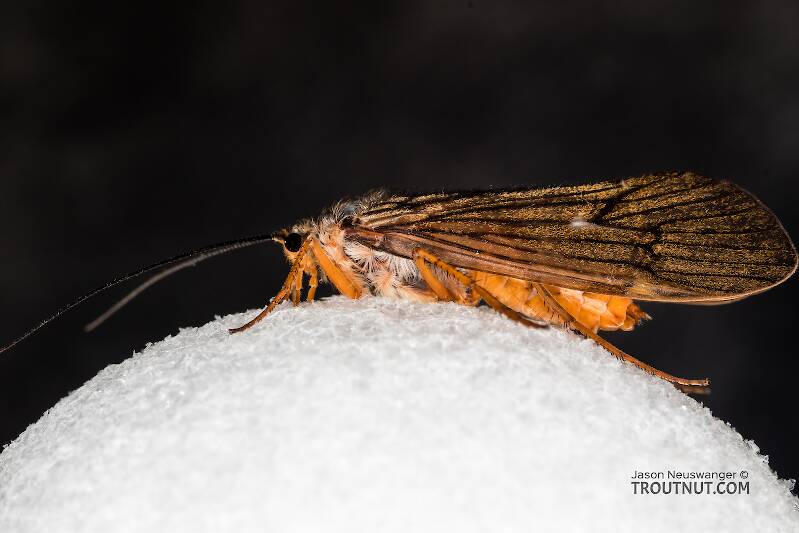
Hex Mayflies
Hexagenia limbata
The famous nocturnal Hex hatch of the Midwest (and a few other lucky locations) stirs to the surface mythically large brown trout that only touch streamers for the rest of the year.
Featured on the forum

With a bit of help from the microscope, this specimen keys clearly and unsurprisingly to Hydropsyche.

Troutnut is a project started in 2003 by salmonid ecologist Jason "Troutnut" Neuswanger to help anglers and
fly tyers unabashedly embrace the entomological side of the sport. Learn more about Troutnut or
support the project for an enhanced experience here.
This topic is about the Insect Order Trichoptera
Some say caddisflies are even more important than mayflies, and they are probably right. The angling world has taken a while to come to terms with this blasphemy. Caddis imitations are close to receiving their fare share of time on the end of the tippet, but too many anglers still assume all caddisflies are pretty much the same.Caddis species actually provide as much incentive to learn their specifics as the mayflies do. There is just as much variety in their emergence and egg-laying behaviors, and as many patterns and techniques are needed to match them. Anglers are hampered only by the relative lack of information about caddisfly behavior and identification.
Example specimens
Walleye on Apr 26, 2010April 26th, 2010, 6:16 am EDT
While the Grannom Caddis and Apple Caddis are both from the Brachycentrus Genus, they are seperate "species". I believe much confusion is caused by some who refer to both as the "Grannom". Grannom (species: numerosus) is not the same color, nor does it hatch the same as the Apply Caddis (speicies: applachia). Pupa of the Grannom have a dirty olive, to dark olive body, with brown wing pads, and a brown shuck.They often hatch mid morning. The Apple Caddis Pupa is a light brighter olive, and a amber wing pad and amber to ginger shuck. Apple Caddis tend to hatch later in the afternoon. While size might be the same, the coloration of the adults have a completely different look. Apple Caddis adults have a very light colored wing, and a light (apple green body color). Grannom adults have a brownish wing with a body of dark olive, mixed with brown to black coloration. I have further noticed that the Grannom seem to hatch over much of the stream while Apple Caddis seem to hatch closer to shore. I'm just trying to clear up the problem of some calling both the Grannom, which leads to much confusion.
Every trout is a trophy!
Afishinado on Apr 27, 2010April 27th, 2010, 4:06 am EDT
I read this and saved this post from Gonzo on grannoms. I printed it out and keep in the pages of my caddisfly "bible", "Cadddisflies" by gary LaFountaine. Here is a link to Gonzo's post (3rd one down):
http://www.troutnut.com/topic/298
http://www.troutnut.com/topic/298
Afishinado on Apr 27, 2010April 27th, 2010, 4:09 am EDT
Ooops, link doesn't work. Here's a copy of Gonzo's post:
Grannom, American Grannom, Shadfly, Apple Caddis, Mother's Day Caddis, and Black Caddis are all common names applied to Brachycentrus species. Mother's Day Caddis is the most common Western nickname for Brachycentrus occidentalis, a Western "grannom," but I have also heard this name applied generally to "grannoms" here in the East.
In PA, it is useful to think of "dark grannoms" and "light grannoms." The species your flies are imitating are more typical of the dark grannoms. The "apple caddis" is a light grannom. Most of the important (PA) Brachycentrus species have overlapping hatch periods, so either dark or light imitations (or both) can be called for, depending on the stream.
Here's my current breakdown for important PA species:
Brachycentrus numerosus--Penn's Creek Caddisfly, Dark Grannom, Dark Shadfly; adults have dark-mottled wings and dark blackish green bodies; pupae usually dark with green lateral stripes and dark wingcases.
Brachycentrus lateralis--Striped Grannom, Dark Grannom, Black Caddis; adults have dark wings and pupae are typically dark olive with tan lateral stripes and dark wingcases.
Brachycentrus nigrosoma--Little Dark Grannom, Little Black Caddis; adults/pupae are smaller and darker than numerosus.
Brachycentrus appalachia--Apple Caddis, Light Shadfly, Light Grannom; adults have very light tannish or grayish wings (almost white when freshly emerged) and apple green bodies; pupae are apple green with tan wingcases.
(Brachycentrus solomoni and incanu are also found in PA. B. solomoni is very similar to numerosus, and incanu is rather rare.)
Most "grannom" activity in PA occurs from mid-April to mid-May. During that time, if you carry imitations of dark and light grannoms (adults and pupae) in sizes #14-16, you should have most bases covered.
You are right that the adult imitations are seldom very good during the emergence (pupa or emerger patterns are best). During the egg-laying activity, however, they are often very effective. The fish may prefer skittered, dead-drifted, or wet adult imitations depending upon the concentrations around their lies.
Grannom, American Grannom, Shadfly, Apple Caddis, Mother's Day Caddis, and Black Caddis are all common names applied to Brachycentrus species. Mother's Day Caddis is the most common Western nickname for Brachycentrus occidentalis, a Western "grannom," but I have also heard this name applied generally to "grannoms" here in the East.
In PA, it is useful to think of "dark grannoms" and "light grannoms." The species your flies are imitating are more typical of the dark grannoms. The "apple caddis" is a light grannom. Most of the important (PA) Brachycentrus species have overlapping hatch periods, so either dark or light imitations (or both) can be called for, depending on the stream.
Here's my current breakdown for important PA species:
Brachycentrus numerosus--Penn's Creek Caddisfly, Dark Grannom, Dark Shadfly; adults have dark-mottled wings and dark blackish green bodies; pupae usually dark with green lateral stripes and dark wingcases.
Brachycentrus lateralis--Striped Grannom, Dark Grannom, Black Caddis; adults have dark wings and pupae are typically dark olive with tan lateral stripes and dark wingcases.
Brachycentrus nigrosoma--Little Dark Grannom, Little Black Caddis; adults/pupae are smaller and darker than numerosus.
Brachycentrus appalachia--Apple Caddis, Light Shadfly, Light Grannom; adults have very light tannish or grayish wings (almost white when freshly emerged) and apple green bodies; pupae are apple green with tan wingcases.
(Brachycentrus solomoni and incanu are also found in PA. B. solomoni is very similar to numerosus, and incanu is rather rare.)
Most "grannom" activity in PA occurs from mid-April to mid-May. During that time, if you carry imitations of dark and light grannoms (adults and pupae) in sizes #14-16, you should have most bases covered.
You are right that the adult imitations are seldom very good during the emergence (pupa or emerger patterns are best). During the egg-laying activity, however, they are often very effective. The fish may prefer skittered, dead-drifted, or wet adult imitations depending upon the concentrations around their lies.
Martinlf on Jan 8, 2013January 8th, 2013, 2:40 pm EST
Does anyone have any good Apple Caddis recipes? I want to get ready for spring on the Delaware and have some tying time now.
"He spread them a yard and a half. 'And every one that got away is this big.'"
--Fred Chappell
--Fred Chappell
Wbranch on Jan 8, 2013January 8th, 2013, 6:35 pm EST
Louis,
I have both a pupa and adult that work quite well. I'll email you photos and tying recipes - with instructions if any steps are complicated.
I have both a pupa and adult that work quite well. I'll email you photos and tying recipes - with instructions if any steps are complicated.
Catskill fly fisher for fifty-five years.
Martinlf on Jan 9, 2013January 9th, 2013, 2:41 am EST
Thanks, Matt,
"He spread them a yard and a half. 'And every one that got away is this big.'"
--Fred Chappell
--Fred Chappell
Entoman on Jan 9, 2013January 9th, 2013, 4:23 pm EST
Louis,
Here's a thread from last year you might find interesting to revisit.
http://www.troutnut.com/topic/6591/Brachycentrus-Pupal-Behavior
Here's a thread from last year you might find interesting to revisit.
http://www.troutnut.com/topic/6591/Brachycentrus-Pupal-Behavior
"It's not that I find fishing so important, it's just that I find all other endeavors of Man equally unimportant... And not nearly as much fun!" Robert Traver, Anatomy of a Fisherman
Afishinado on Jan 10, 2017January 10th, 2017, 10:39 pm EST
Here is some great info posted by LLoyd Gonzales aka Gonzo a long while back on Grannoms in the PA and Catskill area:
http://www.troutnut.com/topic/2273/Grannom-vs-Apple-Caddis
http://www.troutnut.com/topic/2273/Grannom-vs-Apple-Caddis
Quick Reply
Related Discussions
Topic
Replies
Last Reply
0
Mar 23, 2010
by Troutboomer
by Troutboomer
0
May 6, 2011
by Jtberez
by Jtberez






